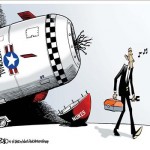Syria is in flames. What started out as a civil war off-shoot of the Arab Spring is rapidly escalating into a regional sectarian conflict and a great power geopolitical fault line that could determine the course of the Middle East for years to come.
Economically, five years after the worst crisis since the Great Depression, the world remains awash in debt, durably high unemployment and meager growth. A generation of Europeans and Americans could be lost amid profound economic malaise.
No nation, free or totalitarian, has satisfactorily reconciled the dilemma over an ever expanding welfare state supported by a dwindling cohort of productive workers, each struggling to survive amid ever more onerous government interventions. Collectively, the world has simply kicked the can down the road, creating the certainty of much harsher, potentially destabilizing economic choices in the future.
These are just two of the transcendental issues of our day. These are the challenges that call for visionary leadership. These are the types of challenges that in the past have galvanized American presidents to action.
This week, President Obama traveled to Berlin to deliver a speech at the iconic Brandenburg Gate. It was here that John Kennedy declared solidarity with the besieged people of West Berlin during the tensest period of the Cold War. It was here that Ronald Reagan called on the Soviets to “tear down” the Berlin Wall. Put the Gate and an American president together and history is usually the result.
So what was President Obama’s grand vision amid a world convulsing with tumult?
Nuclear arms control.
Not Iran and North Korea, mind you. No, the President was calling for yet another round of bilateral strategic arms reductions with the Russians.
The choice of policy announcement is as vexing as it is quaint and potentially dangerous.
Arms control efforts since 1987 have reduced the US arsenal by 80 percent. Today, according to the Bulletin of Atomic Scientists, the US has deployed 1,950 strategic nuclear weapons on land-based missiles (ICBMs), submarine launched missiles (SLBMs) and strategic bombers, the so called “triad” of nuclear deterrence.
Russian numbers have fallen correspondingly, with the Kremlin deploying a combined 1,800 warheads. Under an accord signed by President Obama and the Russians earlier in POTUS’ term, both countries have committed to lowering their total deployed strategic nuclear weapons to 1,500, the lowest level since the mid-1950s.
This generation of weapons reduction was made possible not by a burst of arms control ingenuity, but by the collapse of the Soviet Union. Simply stated, one side won and the other lost. The end of the ideological conflict that raged for nearly half a century robbed nuclear weapons of their importance, as former foes transitioned into an intellectual unity of purpose on nuclear weapons. These arms were vital until they weren’t. That in turn, made genuine and tangible arms reduction possible.
After 25 years, however, the rationale for continued, bilateral cuts between the US and Russia requires serious re-examination. For the first time since the dawn of the nuclear age, the question is not how many additional weapons will make us secure, as in past decades, but how few. That discussion occurs against the backdrop of a larger and more uncertain nuclear club that has grown over the past decades.
The UK and France have roughly 500 warheads between them. India and Pakistan reportedly have 250 warheads combined. The Israelis are said to possess up to 100 warheads. And the North Koreans are thought to possess about 10. In addition, since 1990, Iran, Iraq, Libya and Syria have all had nuclear programs – only the Iranian program is active and close to fruition.
And of course there is China.
It is a new and very different world from that which we lived in only a few decades ago. And it requires a different security calculus. But apparently not for President Obama, who seems enthralled by the days of US Russian summits and arms treaties.
In his speech in Berlin, the President called for an additional 30 percent reduction in deployed strategic weapons between the US and Russia, taking both sides down to 1,000 weapons. But despite all the hype, this is a goal without a purpose, and it poses significant dangers to US strategic interests.
The first danger is capability. While Russia and China continue to invest billions in modern nuclear delivery systems, the US arsenal is frozen in time. The US land-based missile is the Minuteman III, deployed in 1970. The biggest component of the American strategic bomber force remains the venerable B-52, which has been in the field since Dwight Eisenhower was president. The last strategic submarine of the Ohio class became operational in 1997. The latest submarine based missile, the Trident D-5, was deployed in 1990.
While the Air Force’s capability was significantly augmented by the introduction of the B2 stealth bomber into service in 1997, there are currently no operational plans to modernize the rest of the US nuclear deterrent, putting into question our ability to retaliate in the event of surprise attack, as systems age well past their operational prime. Reduced numbers, as the president has called for, places increased burden on aging systems.
The second danger is the nuclear balance of power. The wild card here is China. According to international arms control groups, China is said to have roughly 250 strategic nuclear weapons. Notably, the Chinese have never said how many missiles/warheads they have, beyond claiming a national posture of “minimum deterrence.”
However, the world was rocked by revelations in 2012 that China had constructed a sophisticated and truly massive tunnel network – more than 3,000 miles of deeply buried and fortified networks, dubbed the “Underground Great Wall of China.” Accompanying disclosure of the tunnels were charges that China had secretly assembled a nuclear force of up to 3,000 warheads. Retired Russian General Viktor Yesin estimates that China has at least 1,800 warheads.
While there is considerable controversy over the veracity of China’s “nuclear breakout,” any increase in China’s strategic nuclear capability, beyond the internationally accepted 240 warheads, would create a radically different security threat for the US. Instead of nuclear parity with Russia, with all other nuclear capable nations combined having fewer weapons than either power, the US would be faced with possible nuclear inferiority against the Chinese at a level of 2-1 or even 3-1.
Never in history has the US been at such a nuclear disadvantage.
The third and final danger is the concessions required for an agreement. The President’s enthusiasm for nuclear weapons reductions is not shared by the Russians, at least not as a priority in the bilateral relationship. But that will not stop the Russians from using such bilateral talks to place damaging limitations on the one technology that remains a US game changer in the nuclear arms arena – missile defense.
Despite considerable bravado that US missile defense programs are easily overcome, the Russians are actually quite terrified of US missile defense capability, both real and imagined. Any US advances in missile defense potentially negates decades of Russian investment in missile production, and threatens the credibility of Russia’s ability to deter attack.
Hobbling or ending US missile defense programs has been the staple of both Soviet and Russian negotiating strategy since 1985. Beginning with President Obama, however, the US was only too happy to oblige.
In order to get a strategic arms agreement with Vladimir Putin, President Obama knowingly sold out the Poles and canceled a planned missile defense site in Poland, after strenuous Russian objections. It would be no surprise then that any Russian engagement on a new strategic agreement would require additional, binding limitations on US missile defenses, currently the only strategic gap-filler available to the US in light of new nuclear threats and capabilities globally.
The remaining question is what would the Obama administration be willing to trade for a 30 percent reduction in warheads with the Russians?
It is time to stop this folly now before it becomes a genuine threat to US national security. Indeed, looking across the globe, the US appears to be the only major nuclear power not modernizing its forces or increasing its capabilities.
What kind of balanced reduction is that?
Instead of aimless and de facto unilateral nuclear disarmament, the US should conduct a cold and calculated analysis of the current global nuclear balance.
Let’s find out what the Chinese have going on in those tunnels. Let’s put together a 20-year plan to modernize the US deterrent to ensure that it remains capable, reliable and survivable. Let’s reconcile the capability of our missile defense efforts with the strategic situation to ensure that the American people can never be held hostage to nuclear blackmail, and fund that program to completion. And instead of bilateral talks with the Russians, let’s begin global talks with all nuclear powers with the proviso that there will be no US reductions until everyone participates.
Throughout the Obama administration there has been a veiled conceit that if only the US would rid itself of nuclear weapons then the world would follow. The President’s speech in Berlin was very much in that tradition. But the fact remains that after four years of reductions, existing nuclear powers are doubling down on new systems while emerging powers – such as Iran – frantically speed efforts to acquire a nuclear capability.
The President’s effort to reduce American weapons is not greeted as a sign of change and good will – begetting reciprocal action, but rather a naive and misplaced policy – and golden opportunity – for other nations to gain advantage.
Everyone seems to get this except the Obama administration.
We continue on our current path at our own peril.

